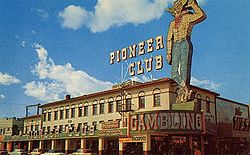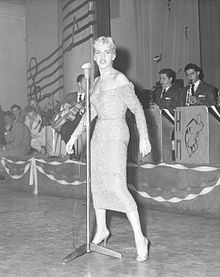Las Vegas in the 1950s
The 1950s was a time of considerable change for Las Vegas. By the 1950s, there were 44,600 living in the Las Vegas Valley.[1] Over 8 million people were visiting Las Vegas annually in 1954, pumping $200 million into casinos, which consolidated its image as "wild, full of late-night, exotic entertainment".[2] The population grew dramatically from 8,422 during World War II to over 45,000.[2] From 1952 to 1957, through money and institutional lending provided by the
1950–51
While
In 1950, the Last Frontier's Western Village was converted into the

Above-ground nuclear tests began at the Nevada Test Site, north of Las Vegas (65 miles (105 km) from downtown Las Vegas) on 27 January 1951. After it was shown on television on 22 April 1952, the Las Vegas town and the nation was gripped by the atomic fever and the Chamber of Commerce even brought out a calendar showing the vantage points to view the atomic sites. Atomic Cocktails, Atomic hair-dos, and Miss Atomic Blast beauty contests became popular with people in some of the casinos.[6][7] Testing continued until the 1963 Test Ban Treaty came into effect and surface testing was banned and underground testing became mandatory.
In 1951, the Eldorado Club downtown was converted into Binion's Horseshoe Casino by Benny Binion.[8] Binion styled the casino like an old-style riverboat, with low ceilings and velvet wallpaper. It was the first casino to have carpeting, as well as comps that were offered to all gamblers. He instituted high table limits and set the craps table limit at $500—ten times higher than any other casino in Las Vegas at the time. Ultimately, Binion's raised the table limit to $10,000 and even eliminated table limits completely at times, which was an immediate hit. Binion later served time in the Leavenworth Penitentiary from 1953 to 1957 for tax evasion and sold his share of the casino to fellow gambler Joe W. Brown. While Brown operated the casino, he installed the famous $1 million display on the casino floor. He sold the display in 1959, and it was later recreated using 100 $10,000 bills by Binion in 1964 when he regained control of it.[8] The display became one of the casino's attractions.

1952–53

The

1954–55
By 1954, over 8 million people were visiting Las Vegas yearly pumping $200 million into casinos. Gambling was no longer the only attraction; the biggest stars of films and music like Frank Sinatra, Dean Martin, Andy Williams, Liberace, Bing Crosby, Carol Channing, and others performed in intimate settings. After coming to see these stars, the tourists would resume gambling, and then eat at the gourmet buffets that have become a staple of the casino industry. As the city became a centre for gambling, illegal activity became rife and many muckraking scandals emerged in the press during the 1950s and 1960s. For instance, in 1954, County Sheriff Glen Jones was revealed as a brothel owner and led to the resignation of state Democratic Governor Clifford Jones.[13]
A new utility company,

The Last Frontier held a two weeks show by
The Showboat was built by William J. Moore of the Last Frontier and J. Kell Houssels of the Las Vegas Club[17] for $2 million.[18] The first resort within Las Vegas city limits, it had 100 rooms on two floors.[19] While Moore and Houssels ran the hotel, the casino was leased by a group of managers from the Desert Inn, including Moe Dalitz.[18] After several unsuccessful years, Joe Kelley took over management, and began successfully targeting local customers with forty-nine cent breakfast specials and other promotions. Kelley added a bowling alley in 1959, which soon became the Showboat's signature attraction, hosting nationally televised PBA tournaments.
The
The
1956–57

The
The "Minsky's Follies", a debut show of the Showgirls opened at the Desert Inn on 10 January 1957. The
On 10 September 1957, the
1958–59

By 1958, the Stardust brought in the French production show, Lido de Paris.[29] The Gaming Commission of Nevada was established on 30 March 1959. In 1959, the Clark County Commission built the Las Vegas Convention Center, which would become a vital part of the area's economy. The Las Vegas sign board, an iconic symbol of Las Vegas, titled “Welcome Las Vegas Nevada” which is an illuminated sign board designed by Betty Willis for Young Electric Sign Company (YESCO), was installed in 1959.[7]
Commercial and residential developments developed north and east of Charleston Boulevard.[14] Prudential Homes announced it would build 640 homes in what is now Lorenzi Park.[30] In the late 1950s and early 1960s, the Miranti brothers of American Homes, built a number of large family home developments in the Las Vegas vicinity.[31] In the early 1950s, Louigi's Italian restaurant opened on the strip; by the mid-1950s, the Venetian Pizzeria opened near Downtown; and in the later part of the decade, Tony's Italian Restaurant opened on Fremont Street.[32]
References
- ISBN 978-1-4236-0488-4.
- ^ ISBN 978-0-252-07090-7.
- ^ "Las Vegas in the 1950s". Official website of Las Vegas. Archived from the original on 1 July 2014. Retrieved 4 June 2013.
- ^ "History". City of Las Vegas. Archived from the original on 1 July 2014. Retrieved 30 June 2013.
- ISBN 9780874171402.
- ^ a b "Time Line". Las Vegas Sun. Retrieved 4 June 2013.
- ^ a b c "100 Years and Growing: 1950s: Vegas Landmarks". Chamber of Commerce Las Vegas. Retrieved 4 June 2013.
- ^ a b Spillman, Benjamin (22 August 2008). "Recurring currency". Las Vegas Review-Journal. Retrieved 5 June 2013.
- ^ "Timeline". Las Vegas Sun. Nov 20, 2008. Retrieved July 27, 2017.
- ^ "Sahara". Digital Library. Retrieved 5 June 2013.
- ISBN 978-0-7627-5819-7.
- ISBN 978-0-8108-7738-2.
- ISBN 978-0-7385-2416-0.
- ^ ISBN 978-0-87417-709-1.
- ISBN 978-0-7864-5362-7.
- ISBN 978-0-7385-2416-0.
- ISBN 978-0-87417-615-5.
- ^ a b "Shows to start at midnight for new Showboat". Billboard. September 4, 1954. p. 34. Retrieved 12 May 2012.
- ISBN 978-0-87417-356-7.
- ISBN 978-0-470-49609-1.
- ISBN 0-8160-4981-5
- ISBN 978-1-932173-32-1.
- ISSN 0024-3019.
- ISBN 978-0-87417-301-7.
- ^ "Las Vegas Hotels and Casino's". University of Nevada. Retrieved 5 June 2012.
- ^ "USO Wayne Newton". USO.org. Archived from the original on 3 March 2009. Retrieved 5 June 2013.
- ISBN 0-87417-615-8.
- ^ ISBN 0-87417-356-6.
- ISBN 978-1-118-26876-6.
- ISBN 978-0-87417-615-5.
- ISBN 978-0-87417-681-0.
- ISBN 978-0-87417-616-2.

